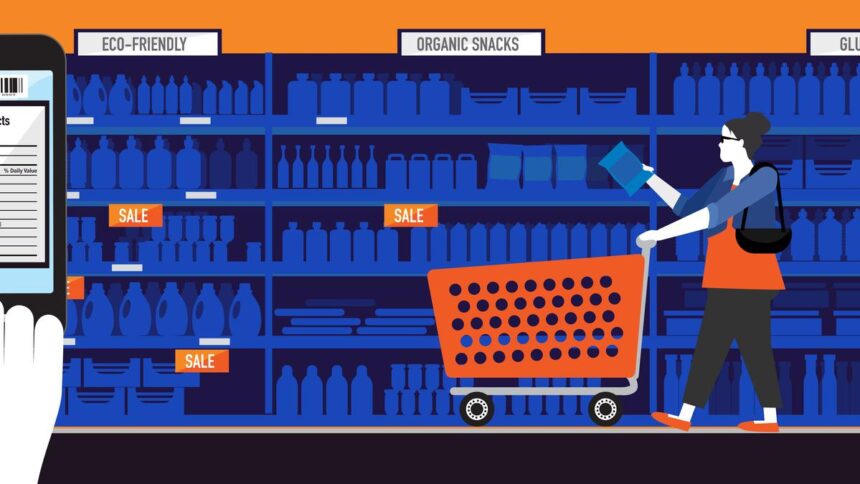
For representative purposes. | Photo credit: Getty Images
The story so far: A new report published by the Access to Nutrition Initiative (ATNi), a non-profit global foundation, found that leading food and beverage (F&B) companies, on average, sell less healthy products in low- and middle-income countries (LMICs). ) compared to what is sold in high-income countries (HIC). This report, which is the fifth edition of the ‘Global Access to Nutrition Index’, states that the world’s 30 largest F&B producers – 23% of the global F&B market – are on track to improve access to nutritious food.
See also: Food packaging should have a label on the front about the health effects, says the WHO
What are the findings of the report?
The report analyzed 52,414 products – including from popular brands such as Nestle, Pepsico, Unilever, Coca-Cola and Hershey and others – using a health star rating system.

In this system, products are rated out of 5 for their healthiness, with 5 being the best, and a score above 3.5 being considered a healthier option. This system assesses food components considered to increase risk (energy, saturated fat, total sugar and sodium) and balances components considered to reduce risk (protein, fiber and fruits, vegetables, nuts and legumes) to calculate the final score which is converted into a star rating. ATNi’s report found that ‘portfolio health’ was found to be lowest in LMICs, indicating disparities in the products offered in different markets. The healthiness of food products in LMICs scored lower – 1.8 in the system – than in HICs which scored 2.3. Only 30% of companies have demonstrated a strategy to price some ‘healthy’ products at affordable prices for low-income consumers, the report found. Also found in LMICs, micronutrient data are available for a smaller proportion of products than those in HICs.
Is this the first time?
This is not the first example of such findings: in April this year, a report by the Swiss NGO, Public Eye and the global coalition International Baby Food Action Network (IBFAN), found that Nestle baby food products are sold in India as well. African and Latin American countries, have a higher sugar content than the same products sold in the European market. When Nestle refused, the central government asked the Food Safety and Standards Authority of India (FSSAI) to initiate “appropriate action” against Nestle.

Why is this so important in India?
India is seeing a Non-Communicable Disease (NCD) burden of epic proportions – an estimated 10.13 crore Indians have diabetes, and according to National Family Health Survey 5 data, obesity is 24% among women and 23% among men. At the same time, malnutrition, anemia and micronutrient deficiencies continue to be important problems.
A large part of the burden of NCDs, experts say, is related to diets that have changed over the past few decades and become unhealthy. Citing the Indian Council of Medical Research (ICMR) dietary guidelines, published in April this year, the Economic Survey of India 2023-24 noted that 56.4% of the total disease burden in India is due to an unhealthy diet. The ICMR report says that consumption of highly processed foods, laden with sugar and fat, coupled with reduced physical activity and limited access to a variety of foods, exacerbates micronutrient deficiencies and overweight/obesity problems.
Another important issue here is affordability: according to UN data more than 50% of Indians cannot afford a healthy diet. At the same time, Indian government data shows that household expenditure on processed food as a proportion of food expenditure has risen, said development economist Dipa Sinha.
What about food packaging labels?
India is a party to World Health Assembly (WHA) resolutions, one of which is the resolution on marketing of food and non-alcoholic beverages to children, which highlights the need to protect children from the marketing of harmful junk food. In 2017, India launched the National Multisectoral Action Plan for Common NCD Prevention and Control, 2017-22 (NMAP). However, there has not been much progress in addressing the food label front.
Activists have been pushing the government for years to bring in regulations for front-of-pack food labels to show their high sugar, fat and sodium content. Draft notification: The Food (Labeling & Display) Amendment and Standards Regulations 2022 were brought, but did not progress for two years, said Arun Gupta, convener, Nutrition Advocacy in Public Interest (NAPi). Research has shown, Dr. Gupta points out, that labels on the front of packaged foods are effective: in Chile and Mexico, for example, the consumption of sugary drinks after the labeling is mandatory.
An analysis by NAPi of 43 advertisements of prepackaged food products and their composition showed that the food contained one or more important nutrients such as saturated fat and others. So far, voluntary efforts by companies have not been enough to ensure widespread and robust nutrition-related performance,” the ATNi report said.
Published – 21 November 2024 08:30 IST




